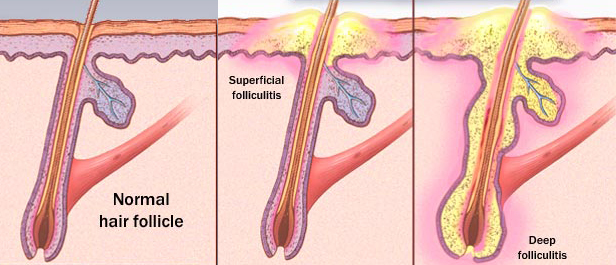Folliculitis After Hair Transplantation
Tuesday, December 21st, 2010 Folliculitis following hair transplantation are skin lesions that appear pimple-like and are seen when (for any reason) hair follicles become inflamed. Folliculitis can be seen anywhere throughout the skin. The follicle and its surrounding tissues may become infected with different bacterias called Streptococcus aureus.
Folliculitis following hair transplantation are skin lesions that appear pimple-like and are seen when (for any reason) hair follicles become inflamed. Folliculitis can be seen anywhere throughout the skin. The follicle and its surrounding tissues may become infected with different bacterias called Streptococcus aureus.
There are also certain variations of folliculitis which are known as “hot tub folliculitis” and “barber’s itch”. Permanent damage to the hair follicles and local hair loss on the area of infection can occur in severe cases of folliculitis.
After Hair Transplant Folliculitis
One of the most common complications of hair transplant surgery is folliculitis. Folliculitis occurs when there is blockage of hair or its corresponding sebaceous gland when newly transplanted hair is growing. Folliculitis typically appears as small, red or white-headed pimples around one or more follicular units following hair transplantation. It may present with itching, mild pain and discharge in addition to the typical redness and swelling of pimples. Most cases of folliculitis (especially those occurring after hair restoration surgery) clear spontaneously within a few days, however more extensive types of folliculitis may need medical or surgical treatment by your physician.
Folliculitis is typically seen a few days or even months after hair transplant surgery. They are generally difficult to be differentiated from common pimples or acne and are recommended to be left alone to clear naturally. Presence of simple folliculitis usually does not affect the growth of transplanted hair. Those instances of folliculitis that do not clear naturally within a few days of forming are considered to be more aggressive and patients are recommended to contact their hair transplant physician at that point.
Treatment
Simple folliculitis generally does not need any treatment and lesions tend to clear up on their own within a few days. Occasionally, when small instances of folliculitis become infected and are seen with spreading of redness and inflammation around the originally inflamed follicles, your physician should be notified. A physician’s evaluation is the best way to determine whether or not you need antibiotics for the treatment of your folliculitis. Occasionally, as a way to avoid use of medication or continuing infection, your doctor may alternatively decide to drain them. Draining the folliculitis is a simple procedure and can be easily done in your doctors’ office.

